The village of Camrose lies about three miles northwest of the County Town of Haverfordwest. The village was originally built around a Norman Motte and Bailey Castle, which is now the site of a 14th Century Manor House, and so has a long history. The Camrose Estate had been in the hands of the Bowen family since the mid 1500’s, but by the time of the Great War the male side of the family had faded away, and the last heir to the estate, Anne Webb Bowen married a Colonel Lewis Penn, and the Estate passed to the Penn family. A grandson of the late Colonel Penn died during the early part of the Great War, and is remembered on a plaque inside the Parish Church of St. Ismael. Inside the church is also another brass plaque, which commemorates the memory of the men of the village who lost their lives during both World Wars.
The Great War, 1914-1918
John Henry Absalom, Private, 29148, Welsh Regiment. John was the son of Owen and Lydia Absalom, The Causeway, Camrose. He enlisted at Haverfordwest on 1 March 1915 into the Welsh Regiment, and was posted to the 14th (Swansea) Battalion, Welsh Regiment, which was attached to 114 Brigade, 38th (Welsh) Division. The Division had landed in France during December 1915 and had spent their first winter in the trenches near Armentieres. In June they marched south to the Somme, where they were tasked with the capture of Mametz Wood. The attack on the wood began on 7 July, but met with fierce resistance, and it took until 14 July to clear the wood. John was killed during heavy fighting in the wood during the second assault, on 10 July 1916, aged just 18. He has no known grave, and is remembered on the Thiepval Memorial, France.
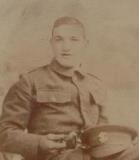
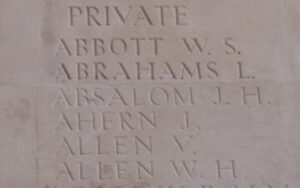
William Allen, Shoeing Smith, 99221, Royal Field Artillery. William was the son of William and Frances Allen, of Manorbier. He resided at Nock Farm, Camrose prior to the war, and enlisted at Woolwich into ‘B’ Battery, 177th Brigade, Royal Field Artillery. The Battery formed in England, and joined the 16th (Irish) Division, moving to France on 22 February 1916. The Division fought on the Somme, before moving to Ypres, where they took part in the Battle of Messines in July 1917. They moved just North of Ypres to the Pilckem area, where on 27 July 1917, in the build up to the Battle of Langemarck, William was killed in Action. He was aged 31, and is buried in Brandhoek New Military Cemetery, Grave II. A. 13. His brother Charles also fell, and is commemorated alongside William on the Manorbier War Memorial.
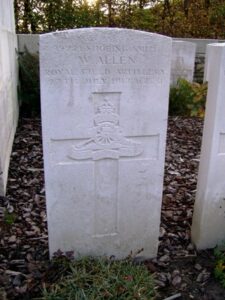
Benjamin Davies, Private, 213014, Welsh Regiment. Benjamin was the son of David Howell Davies and Amy Davies, of Nolton. He married Florence Ellen Bennett in 1912, and the couple lived at Keystone, Camrose. Benjamin enlisted at Haverfordwest into the 13th Battalion, Welsh Regiment, which was attached to 114 Brigade, 38th (Welsh) Division. The Division had landed in France during December 1915 and had spent their first winter in the trenches near Armentieres. In June they marched south to the Somme, where they were tasked with the capture of Mametz Wood. The Division suffered terrible casualties at Mametz, and were taken out of the line, and moved to Ypres to rebuild. Here they fought at the Battle of Pilckem Ridge, and the Battle of Langemarck. They then moved to Armentieres, where they remained from September 1917 until March 1918 when the German Spring Offensive was launched. The British had been over-run on the Somme, and so in April the Division was moved south, taking up positions North of Albert, from where they weathered the storm of the coming months, until the war turned during the Battle of Amiens, on 8 August 1918. Benjamin though was killed before the Germans launched their attack. He was wounded whilst in the front line near Armentieres during early March, 1918 and evacuated to the Hospital at St. Omer, where he died of wounds on 19 March 1918. Benjamin is buried there, at Longuenesse (St. Omer) Souvenir Cemetery, France. His brother Thomas Davies, also fell, and is commemorated at Walton West.
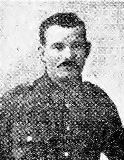
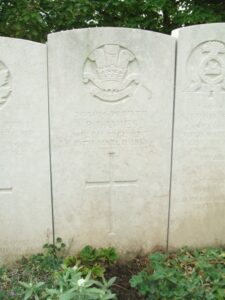
Benjamin Oscar Davies, Private, 1644, Welsh Regiment. Benjamin was the son of Henry and Maria Davies, of Long Island Farm, Camrose. He enlisted at Hafod, Swansea on 29 November 1913 into the 6th Battalion, Welsh Regiment. Benjamin landed in France with the battalion on 28 October 1914, and saw action during First Ypres. Benjamin became ill whilst at Le Bassée, and was sent to the 2nd General Hospital at Richmond for treatment in May 1915, before being discharged from the army on 9 June 1915. Benjamin died of tuberculosis, brought on by his gas poisoning, on 10 June 1916. His case was submitted to the CWGC by myself on 5 August 2012, and he has been accepted for commemoration by the CWGC on Tuesday 22 July 2014. He will be commemorated in the United Kingdom Book of Remembrance, although he is buried in Haverfordwest (St. Thomas A Beckett) Churchyard. His brother, Harding Melbourne Davies, also fell.
Harding Melbourne Davies, Private, 201896, Welsh Regiment. Harding was the son of Henry and Maria Davies, of Long Island Farm, Camrose. Harding worked at the Bryngwyn Steel Company at Gorseinon prior to the war, and enlisted at Carmarthen into the 4th Welsh. He was posted to the 1st Battalion, Welsh Regiment, which was attached to 84 Brigade, 28th Division. The Division formed in England from December 1914, from regular units returning from India, Singapore and Egypt. During January 1915 it moved to France, landing at Le Havre and moved to the Western Front, where it saw its first major action during the Second Battle of Ypres. After taking part in the Battle of Loos, during October 1915, the Division embarked at Marseilles, and proceeded to Egypt, then in November moved on to Salonika where the Division then remained. Harding was wounded in Salonika, and died of his wounds on 19 May 1917. He was 18 years old, and is buried at Karasouli Military Cemetery, Salonika. His brother Benjamin also fell.
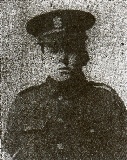
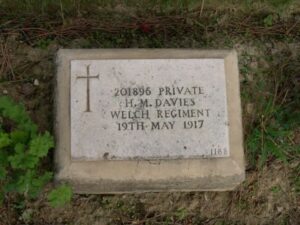
Charles John Randle Dawkins, Second Lieutenant, Welsh Regiment. Charles was the only son of Thomas Randle and Clara Vaughan Dawkins, of Redhill, Haverfordwest. He was educated at Haverfordwest Grammar School and at Clifton College, and was a B.A. and LL.B. of Cambridge, having taken a First in Law and a second in the Historical Tripos. Charles was commissioned into the Welsh Regiment at the outbreak of war, and was posted to the 9th Battalion, which was attached to 58 Brigade, 19th (Western) Division. The Division assembled around Bulford during September 1914. Divisional training was completed near Tidworth, from March 1915, and Charles married Enid Myfanwy Evans, at Camberley on 8 May 1915. The 19th Division crossed to France between the 11 and 21 July 1915, and moved to positions near Loos. On 25 September 1915 the division took part in a diversionary attack near Givenchy, while the main assault was launched to the south. Charles was killed in action during the initial attack of 25 September 1915. He was 24 years old, and is buried at Brown’s Road Military Cemetery, Festubert, France.
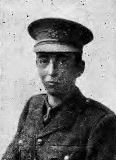
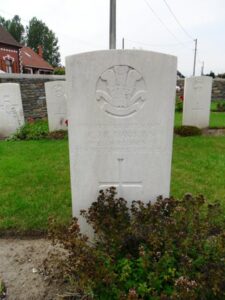
James Devereaux Evans, Stoker 1st Class, 282467, Royal Navy. James was born at Lammas Fold, Camrose on 21 June 1876, the son of William and Emma Evans. He was a pre-war regular in the Royal Navy. At the outbreak of war, there was a surplus of Royal Naval personnel, and an idea was hatched to form a Royal Naval Division, to fight on land. James joined the Howe (6th) Battalion, attached to the 2nd Royal Naval Brigade, Royal Naval Division in August, 1914. The Naval Brigades were originally sent to Antwerp and Dunkirk in September and October, 1914 to guard against invasion by the Germans. However Antwerp fell to the Germans soon after, and so many of the RND units were withdrawn to England. After a lengthy period of refit and training the Division moved to Egypt preparatory to the Gallipoli campaign. Landing on 25 April 1915, the Division fought throughout the entire Campaign on Gallipoli. James was killed in action at Gallipoli on 4 June 1915. He was 29 years old, and has no known grave, and so he is remembered on the Helles Memorial, Gallipoli.
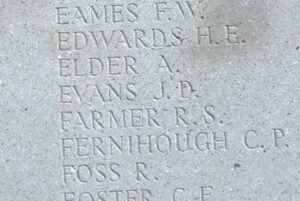
Percy King Finch, Lance Corporal, 29141, Welsh Regiment. Percy was the son of Frederick and Susannah Finch, of East Dulwich. He was a gardener prior to the war, and lived with his wife Amy Gertrude Finch, at The Kilns, Cleddau, Camrose. He enlisted at Haverfordwest into the 14th (Swansea) Battalion, the Welsh Regiment, which was attached to 114 Brigade, 38th (Welsh) Division. The Division had landed in France during December 1915 and had spent their first winter in the trenches near Armentieres. This was the so called ‘Nursery’ or quiet sector where new Divisions were initiated into trench warfare. However, being quieter didn’t make it safe to be there, and sadly Percy was killed in action there on 9 January 1916, when he was shot in the neck by a sniper whilst taking aim at the German trenches himself. He was 29 years old and is buried at Rue-De-Bacquerot No. 1 Military Cemetery, Laventie.
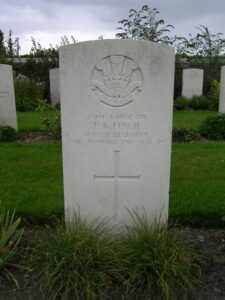
Hubert Thomas George, Private, 320039, Welsh Regiment. Hubert was the son of David and Eliza George, of The Home Farm, Camrose. He enlisted at Haverfordwest at the outbreak of war into the Pembroke Yeomanry, with the Regimental Number 319. The Pembroke Yeomanry had been formed in Tenby in August 1914 as part of the South Wales Mounted Brigade. Originally intended for Home Service, the Battalion was sent as part of the Division to Egypt, for Garrison work on the Suez Canal Defences. In January, 1917 the Pembroke Yeomanry was merged with the Glamorgan Yeomanry to form the 24th Battalion of the Welsh Regiment, which was attached to 231 Brigade, 74th (Yeomanry) Division. The Division had formed in Egypt in January 1917 and had fought through the Palestinian Campaign, at the Battles of Gaza and the Battle and capture of Jerusalem. Due to the terrible casualties suffered by the British on the Western Front in March and April, 1918 the Division was recalled to the Western Front, and arrived at Marseilles during May 1918. They then fought at the Second Battle of Bapaume during the great offensive, and fought in Flanders before returning to the Somme and fighting at the Battle of Epehy, as part of the offensive towards the Hindenburg Line. Hubert was one of the many men of the Battalion to be killed here. He lost his life on 18 September 1918 during an attack on Gillemont Farm, a strongly held German position. Hubert was 26 years old, and is buried near to where he fell, at Unicorn Cemetery, Vend’huile, France.

John Henry John, Private, 127, Pembroke Yeomanry. John was the son William John, of Park House, Haverfordwest, and was the husband of Mary Ann Jepson (formerly John), of 62, Prendergast, Haverfordwest, Pembrokeshire. John had enlisted at Haverfordwest into the 1/1st Battalion, Pembroke Yeomanry at the outbreak of war, and had joined the Battalion at Penally Camp. The Battalion was part of the South Wales Mounted Brigade, 1st Mounted Division, and remained in England until November, 1915 when they moved to Egypt. However, John died of sickness before the move, on 30 October 1915. He was 37 years old and is buried at Camrose Baptist Churchyard. John is not commemorated on the Camrose War Memorial.
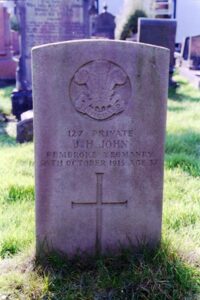
William Bowen Lewis, Private, 50106, Welsh Regiment. William was born in Camrose. He resided in Letterston prior to the war and was the brother of Mr. D. A. Lewis, of 9, Bridge Street, Cardigan. William enlisted at Carmarthen into the 2nd Battalion, the Welsh Regiment, which formed part of the 3rd Brigade, 1st Division. This was a regular Army Division that had been in France since the Battle of Mons, and had fought through almost every major campaign of the Great War. The Division were in French Flanders during the middle of 1918, when they were still in the midst of the epic struggle to hold the German Offensive. William was killed in Action on the 6th June 1918 and is buried in Sailly-Labourse Communal Cemetery Extension, Grave K. 8. William is not commemorated on the Camrose War Memorial, but on the Memorial at nearby Letterston.
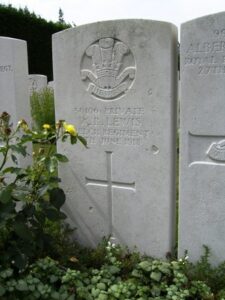
Edward Hugh Mowbrey Penn, Gunner, C/37408, Canadian Field Artillery. Edward was the son of Nina N. Hankey (formerly Penn), of 1209, Belmont Avenue, Victoria, British Columbia, and the late John William Penn. There is very little known of Edward, except that he served with the Canadian Army Service Corps, before joining the 1st Division Ammunition Park, Canadian Field Artillery. Formed in August of 1914, the 1st Canadian Division was a formation of the Canadian Expeditionary Force. The division was initially made up from Provisional Battalions that were named after their Province of origin but these Provisional titles were dropped before the Division arrived in Britain on 14 October 1914. The Division was stationed at Salisbury Plain in England, where they trained ready for the move to the Western Front, but Edward sadly died here before the move, on 3 December 1914. He was 30 years old, and is buried at Bulford Church Cemetery, Dorset. Edward is not commemorated on the War Memorial at Camrose, but on a separate Brass Memorial Plaque inside the Church.

Ewan Maurice Young, Sergeant, G/51286, Middlesex Regiment. Ewan was the son of Morris and Emma Young, of The Folley, Camrose. He enlisted at Haverfordwest into the 26th Battalion, Middlesex Regiment, which was raised in London on 9 August 1915 by Lieut. Col. John Ward M.P. It was taken over by the War Office in November 1915, and moved to Hornchurch. In December 1915 the Battalion moved to Witley, and in June 1916 became attached to the 69th Division in Norfolk. Between July and August 1916 it was attached to the 62nd Division, at Flixton Park, near Bungay. It left the 62nd Division for Devonport and embarked for Salonika, arriving 24th August, 1916 and joined the 27th Division as Pioneer Battalion. They remained here for the duration of the war, and it was here, while the Battalion formed part of the Garrison Force at Salonika after the war, that Ewan took ill and died of bronchial pneumonia on 5 January 1919. He was 28 years old, and is buried at Sarigol Military Cemetery, Kriston, Salonika.
World War Two, 1939-1945
Ernest Warald Newlands Codd, Able Seaman, D/SSX 18007, Royal Navy. Ernest was the son of Ernest and Mary L. Codd of Bunkers Hill, Camrose, and the husband of Olwen Lilian Rose Codd, of Milford Haven. Ernest served with the Royal Navy, aboard H.M.S. Ardent. HMS Ardent was an ‘A’ class destroyer of the Royal Navy. She served during the Second World War in Home waters and off the Norwegian coast. After the German Invasion of Norway, a Royal Naval detachment was sent to Norway. After Norway had fallen, Ardent was detached from her escort duties with the Ark Royal on the 8th June, and joined HMS Acasta in escorting HMS Glorious back to Scapa Flow. Whilst enroute, the three ships were discovered by the German Battlecruiser’s Scharnhorst and Gneisenau. Ardent and Acasta laid a protective smokescreen to hide the British ships, and engaged the German ships with her 4.7 inch main armament, which proved to be ineffective at the range of the targets. Despite coming under heavy fire from the much larger guns of the German Battlecruiser’s, Ardent carried out a torpedo attack. She managed to score a single hit with her 4.7 in gun, but was struck repeatedly by enemy shells. Ardent eventually capsized with the loss of ten officers and 142 ratings. Acasta and Glorious were also sunk in the engagement. Only two of Ardent’s survivors remained to be picked up by a German seaplane five days after the sinking. Ernest was one of the men killed aboard the Ardent that day, on 8 June 1940. He was 25 years old, and is remembered on the Plymouth Naval Memorial, Devon.